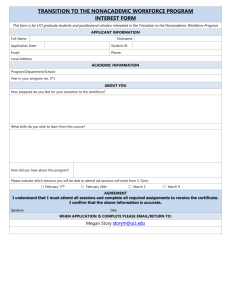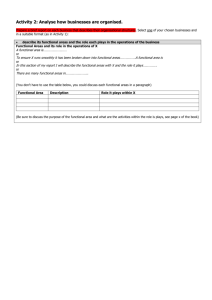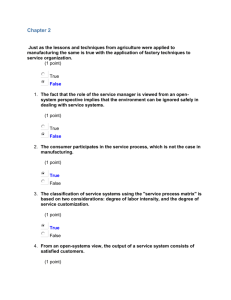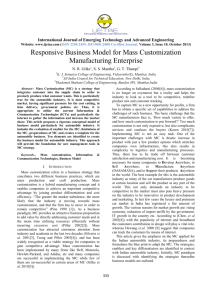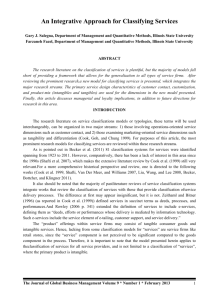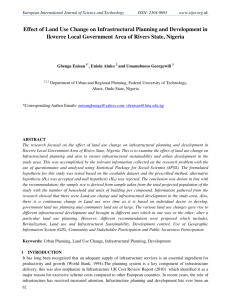DEFINITION OF STRATEGY
advertisement
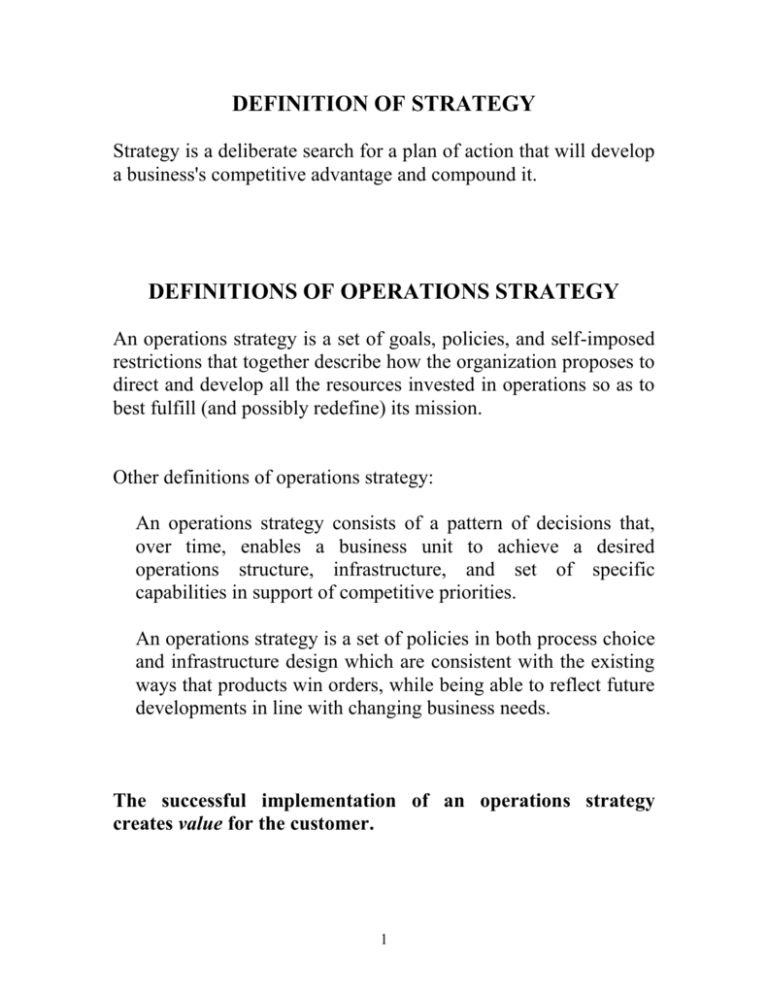
DEFINITION OF STRATEGY Strategy is a deliberate search for a plan of action that will develop a business's competitive advantage and compound it. DEFINITIONS OF OPERATIONS STRATEGY An operations strategy is a set of goals, policies, and self-imposed restrictions that together describe how the organization proposes to direct and develop all the resources invested in operations so as to best fulfill (and possibly redefine) its mission. Other definitions of operations strategy: An operations strategy consists of a pattern of decisions that, over time, enables a business unit to achieve a desired operations structure, infrastructure, and set of specific capabilities in support of competitive priorities. An operations strategy is a set of policies in both process choice and infrastructure design which are consistent with the existing ways that products win orders, while being able to reflect future developments in line with changing business needs. The successful implementation of an operations strategy creates value for the customer. 1 COMPONENTS OF AN OPERATIONS STRATEGY Structural decision categories: Infrastructural decision categories: Capabilities: Competitive priorities: Capacity Facilities Vertical integration (sourcing) Information/process technology Workforce Organization Control/quality systems Unique to each firm Cost Quality High-performance design Functional quality Delivery Fast delivery time On-time delivery Flexibility Customization Volume flexibility Innovation (speed to market) 2 COMPETITIVE PRIORITIES Quality Quality consists of many dimensions that can be aggregated into: high performance design (level of attributes) and functional quality (the ability to operate as intended). Quality Dimensions Category Dimension Definition High Performance A product's or service's primary operating performance characteristics design Features The "bells and whistles" of products and services, those characteristics that supplement their basic functioning Aesthetics How a product looks, feels, sounds, tastes, or smells For services – physical facilities, equipment, and appearance of personnel Perceived Inferences about quality based on indirect quality tangible and intangible aspects of the product or service (e.g. reputation) Functional Reliability The probability of a product malfunctioning quality or failing within a specified time period For services – ability to perform the promised service dependably and accurately Conformance The degree to which product or service design and operating characteristics meet established standards Durability The amount of use one gets from a product or service before it deteriorates Service The speed, courtesy, and competence of delivery personnel For products – also, the ease of repair Improvements in functional quality result from a reduction in process variation. 3 COMPETITIVE PRIORITIES Delivery Two delivery dimensions: Fast delivery time - The time the customer must wait between order placement and receipt On-time delivery - How reliable the company is in delivering a customer's order on or before the quoted delivery date Both lead time and reliability can be improved by reducing uncertainty in the operations system. 4 COMPETITIVE PRIORITIES Flexibility Primary flexibility dimensions: Customization - The ability to produce a wide variety of products or services and the ease with which the product or service mix can be changed Volume flexibility - The ability of the production system to operate at different volumes and the ease with which the volume can be changed. Increased flexibility is a means to deal with demand uncertainty. Advances in technology have greatly increased operational flexibility. 5 COMPETITIVE PRIORITIES Innovation Definition: In operations, innovation as a competitive priority involves the ability to quickly introduce and improve process technologies, which increases speed to market with often better products and services. Main types of operations innovations: Incremental - Minor improvements or simple adjustments in existing technology. Rapid accumulation of these innovations can convey a competitive advantage. Radical - Fundamental changes that represent revolutionary changes in technology. They represent clear departures from existing practice (i.e., substantially new processes and process technologies) Innovation is often the primary competitive priority in a highvelocity environment with short product life cycles. 6 CAPABILITIES Capabilities are business processes strategically understood and implemented. Capabilities are systemic. Capabilities often involve infrastructural, rather than structural, decisions. Thus, they are more difficult to imitate. Capabilities are a means to an end. The "end" is to establish a distinctive competence in support of competitive priorities. Examples: Wal-Mart's logistics system JetBlue’s operations eBay’s operations 7 McDonald’s Operations Mission To produce the highest quality fast-food products that can be made consistently. This must be accomplished with adequate speed, low cost, and process innovation to accommodate consumer tastes. McDonald’s Operational Strategies Dimension Capacity Facilities Process Technology Vertical Integration Workforce Organization Control Systems Strategy Growth as needed through additional stores but capacity added carefully Well-utilized - franchisee's well-being depends on it being used heavily Distributed facilities, each facility being very similar to the next, all focused around the same menu - although the uniformity is beginning to change High degree of process understanding, emphasis on "fool-proof" processes A leader in the technology of fast-food delivery Partnership arrangement Long-term relationship with suppliers to promote innovation and quality improvement Franchisees: well-trained, carefully selected, entrepreneurs Operators: high-turnover, cheap Guidelines provided by corporation, but franchisees push to locally optimize Centralized buying Bulk contracts "Push" system for basic supplies, "pull" system day-to-day in the restaurants 8 Boston College CGSOM’s Operations Mission CGSOM’s Operational Strategies Dimension Capacity Strategy Facilities Process Technology Vertical Integration Workforce Organization Control Systems 9 CRITERIA FOR EVALUATING AN OPERATIONS STRATEGY Consistency (internal and external) Between the operations strategy and the overall business strategy Among the decision categories that make up the operations strategy Between the operations strategy and the other functions’ strategies Between the operations strategy and the business environment (resources available, competitive behavior, governmental restraints, etc.) Contribution (to competitive advantage) Making trade-offs explicit, enabling operations to set priorities that enhance the competitive advantage Directing attention to opportunities that complement the business strategy Promoting clarity regarding the operations strategy throughout the firm Providing the operational capabilities that will be required by the business now and in the future 10 EVOLUTION OF OPERATIONS STRATEGY Stages Stage Operation's strategic role 1 Internally neutral - Minimize operation's negative potential 2 Externally neutral - Achieve parity with competitors 3 Internally supportive - Provide credible support to the business 4 Externally supportive - Pursue an operations-based competitive advantage 11 STAGES OF OPERATIONS STRATEGY Stages 3 and 4 Stage 3 Internally supportive An operations strategy is formulated and pursued Keep operations in step with business strategy Operations investments are screened for consistency with business strategy Longer-term trends are addressed systematically Consistency within operations Translate business strategy into operations terms Stage 4 Externally supportive Anticipate new operations practices and technology Operations is an equal partner in business strategy Operations is involved up front in market decisions Operations contributes to other functions Structure and infrastructure are concerns to top management Teamwork and involved workforce Operations is innovative Competitive strategy rests on operations capability Functions of the firm are well integrated Proprietary equipment developed 12 ATTACKING AND DEFENDING THROUGH OPERATIONS Attacking: Positioning – Appealing to a different customer need Capabilities – being better at the same game Process-based capabilities Systems (coordination)-based capabilities Organization-based capabilities Capability-pairing Defending: Exploiting its own strengths Attacking its attacker’s operations-based weaknesses Recognizing the seriousness of the attack quickly and emulating the attacker’s strategy 13 INFORMATION-INTENSIVE INDUSTRIES, E-COMMERCE Characteristics and Implications for Operations Characteristics: 1. The cost structure for most information-intensive products is dominated by the “up-front” costs associated with developing a new product and creating its associated production/delivery facilities. 2. Rapid changes in technology and markets. 3. Network effects (i.e. the increasing attractiveness to users of certain networks as they increase in size). Network effects are a function of the number of users of a particular technology and the system of complementary products associated with the network. 4. Quality and time have an interaction effect. 5. Information technology communication with users. enables direct, real-time 6. Compatibility is as important as differentiation. Implications: Increased importance of project (vs. process) management. (1) Cumulative output and speed to market are key for low-cost strategies. (1, 2, 3) Installing a less-than-perfect but improvable system is more important than introducing a more elegant system later. (4) High flexibility (customization) is at least an order qualifier. (5) Operations must be able to introduce new products and services rapidly. (1, 2, 3) Operations organized for collaboration and communication. (6) 14





